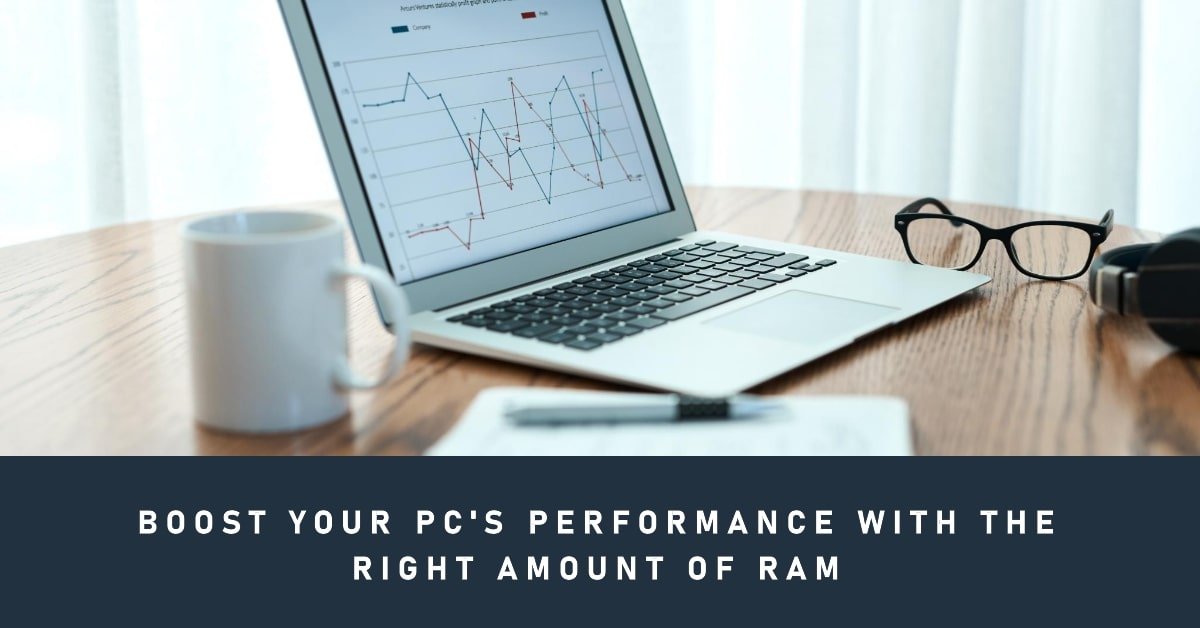RAM, or random access memory, is one of the most crucial components of your PC. It stores data temporarily so that your processor can access it quickly and run applications smoothly. But how much RAM does your PC need to work faster? How can you check and upgrade your RAM if you need more? In this article, we’ll answer these questions and more. Read on to find out everything you need to know about RAM and how it affects your PC’s performance.
What Is RAM and Why Is It Important?
RAM is a type of volatile memory, which means that it only stores data while your PC is powered on. When you turn off your PC, the data in RAM is erased. This is different from your hard drive or SSD, which stores data permanently even when your PC is off.
RAM is important because it allows your processor to access data faster than from your storage device. The more RAM you have, the more data your processor can store and retrieve without having to wait for your hard drive or SSD. This means that your PC can run multiple applications at once, switch between them quickly, and load them faster.
However, having more RAM doesn’t always mean having a faster PC. Other factors affect your PC’s speed, such as your processor, graphics card, storage device, and operating system. Also, having too much RAM can be a waste of money if you don’t use it. That’s why it’s important to know how much RAM you need for your specific needs and tasks.
How to Check How Much RAM You Have
Before you decide to upgrade your RAM, you should check how much you already have. This is easy to do on both Windows and Mac computers.
If you’re using a Windows 10 PC, click the Start menu and type “About Your PC”. This will bring up the system information screen, where you can see the installed RAM your PC has.
If you’re using a Windows 11 PC, press Ctrl+Shift+Esc to open the Task Manager. Here you can click the Performance tab, which will display your PC’s RAM.
If you’re using a Mac, click the Apple icon and select “About This Mac”. This will show you your Mac’s statistics, including memory.
How Much RAM You Need for Different Tasks and Applications
The amount of RAM you need depends on what you use your PC for. Different tasks and applications require different amounts of RAM to run smoothly and efficiently. Here are some general guidelines for how much RAM you need for common tasks and applications.
Basic Computing: 8GB
If you use your PC for basic tasks, such as browsing the web, watching streaming content, or using word processors, 8GB of RAM is the minimum you’ll want. This amount of RAM should allow you to have multiple tabs open and switch between them without significant performance degradation. You can even do some light photo or video editing with 8GB of RAM, though you may experience some long load times.
Gaming: 16GB or More
If you’re a gamer, you’ll want more RAM to run modern games that are graphically demanding and require a lot of resources. 16GB of RAM is the recommended amount for most gamers, as it will let you play most games at high settings and resolutions without lag or stuttering. However, some games may require more than 16GB of RAM, especially if you want to play them at ultra settings or with mods. In that case, you may want to go for 32GB or even 64GB of RAM, depending on the game and your preferences.
Creative Work: 32GB or More
If you’re a creative professional, such as a graphic designer, video editor, music producer, or 3D modeler, you’ll need a lot of RAM to handle complex and large files and projects. 32GB of RAM is the minimum you’ll need for most creative work, as it will let you run multiple programs and work with multiple layers and effects without slowing down your PC. However, if you work with very high-resolution or 4K files, or if you use multiple monitors, you may need more than 32GB of RAM. In that case, you may want to opt for 64GB or even 128GB of RAM, depending on your workflow and needs.
How to Upgrade Your RAM
If you find that your PC doesn’t have enough RAM for your needs, you may want to upgrade it. Upgrading your RAM can improve your PC’s performance and speed, and it’s not very difficult or expensive to do. However, there are some things you need to consider before you upgrade your RAM, such as:
- Your PC’s motherboard and processor: Your PC’s motherboard and processor determine how much RAM your PC can support and what type of RAM you need. You need to check your PC’s specifications and compatibility before you buy new RAM modules. You can use online tools, such as Crucial’s System Scanner, to find out what type of RAM your PC needs and how much it can support.
- Your PC’s form factor: Your PC’s form factor, whether it’s a desktop or a laptop, affects how easy or hard it is to upgrade your RAM. Desktop PCs usually have more space and slots for RAM modules, making it easier to upgrade. Laptops, on the other hand, may have less space and slots, or even soldered RAM, making it harder or impossible to upgrade. You need to check your PC’s manual or online guides to see how to access and replace your RAM modules.
- Your PC’s warranty: Your PC’s warranty may be affected by upgrading your RAM. Some PC manufacturers may void your warranty if you open your PC and replace your RAM modules. Others may allow you to upgrade your RAM without affecting your warranty, as long as you don’t damage your PC in the process. You need to check your PC’s warranty terms and conditions before you upgrade your RAM.
Once you’ve checked these factors and bought the right RAM modules for your PC, you can follow these steps to upgrade your RAM:
- Turn off your PC and unplug it from the power source.
- Open your PC’s case or panel and locate the RAM slots on the motherboard.
- Remove any existing RAM modules by gently pushing down the clips on the sides and pulling them out.
- Insert the new RAM modules into the empty slots, making sure they align with the notches, and click into place.
- Close your PC’s case or panel and plug it back into the power source.
- Turn on your PC and check if it recognizes the new RAM.
Faster RAM vs. More RAM
When it comes to RAM, two main factors affect its performance: speed and capacity. Speed refers to how fast your RAM can transfer data to and from your processor, measured in megahertz (MHz). Capacity refers to how much data your RAM can store at once, measured in gigabytes (GB).
So, which one is more important: faster RAM or more RAM? The answer depends on your PC and your needs. Generally speaking, having more RAM is better than having faster RAM, as it will allow you to run more applications and tasks without running out of memory. However, having faster RAM can also improve your PC’s performance, especially if you have a high-end processor and graphics card that can take advantage of it.
The best way to decide between faster RAM and more RAM is to check your PC’s specifications and compatibility, and see what speed and capacity of RAM your PC can support. You can also use online tools, such as UserBenchmark, to compare different RAM models and see how they affect your PC’s performance.
Future-Proof Your PC
Another factor to consider when choosing how much RAM you need is how long you want your PC to last. Technology evolves rapidly, and new applications and games may require more RAM in the future. If you want your PC to be able to handle future demands, you may want to invest in more RAM than you currently need. This way, you can future-proof your PC and avoid having to upgrade your RAM again soon.
However, future-proofing your PC also has some drawbacks. For one, it can be more expensive to buy more RAM than you need. For another, it can be hard to predict how much RAM you’ll need in the future, as technology can change unpredictably. Therefore, you should balance your current and future needs and budget when deciding how much RAM you need.
FAQs
Here are some frequently asked questions about RAM and how much you need.
How do I know if I need more RAM?
Some signs indicate that you may need more RAM, such as:
Your PC is slow or freezes when you run multiple applications or tabs
Your PC crashes or shows error messages when you run memory-intensive applications or games
Your PC takes a long time to boot up or shut down
Your PC’s fan is loud or overheats when you use your PC
If you experience any of these issues, you may want to check your RAM usage and see if you’re running out of memory. You can do this by using the Task Manager on Windows or the Activity Monitor on Mac, which will show you how much RAM your PC is using and how much is available.
How do I free up RAM on my PC?
If you don’t have enough RAM for your needs, you can try to free up some RAM by doing the following:
Close any applications or tabs that you’re not using
Disable any unnecessary startup programs or background processes that run on your PC
Use a memory cleaner or optimizer tool, such as CCleaner or IObit Advanced SystemCare, to clear your RAM cache and optimize your PC’s performance
Scan your PC for malware or viruses that may consume your RAM
Update your drivers and software to fix any bugs or issues that may affect your RAM
How do I install more RAM on my PC?
If you want to install more RAM on your PC, you’ll need to buy compatible RAM modules and replace or add them to your PC’s motherboard. The process may vary depending on your PC’s model and form factor, but here are some general steps to follow:
Turn off your PC and unplug it from the power source
Open your PC’s case or panel and locate the RAM slots on the motherboard
Remove any existing RAM modules by gently pushing down the clips on the sides and pulling them out
Insert the new RAM modules into the empty slots, making sure they align with the notches and click into place
Close your PC’s case or panel and plug it back into the power source
Turn on your PC and check if it recognizes the new RAM
Conclusion
RAM is an essential component of your PC that affects its speed and performance. How much RAM you need depends on what you use your PC for and how long you want it to last. Generally, you’ll want at least 8GB of RAM for basic computing, 16GB or more for gaming, and 32GB or more for creative work. However, you should also check your PC’s specifications and compatibility, and see what speed and capacity of RAM your PC can support. You can also use online tools to compare different RAM models and see how they affect your PC’s performance. If you need more RAM, you can upgrade it by buying compatible RAM modules and installing them on your PC’s motherboard. By doing so, you can improve your PC’s performance and future-proof it for years to come.



